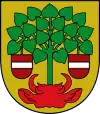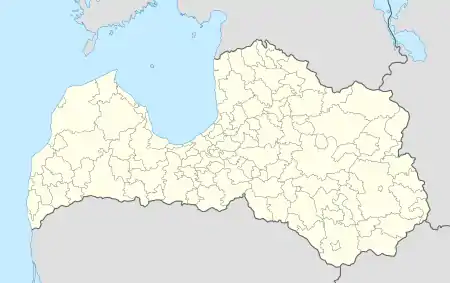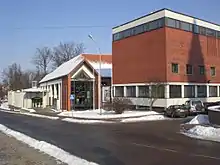Valmiera
Valmiera (![]() pronunciation ; German: Wolmar; Polish: Wolmar see other names) is the largest city of the historical Vidzeme region, Latvia, with a total area of 19.35 square kilometres (7 square miles). As of 2002, Valmiera had a population of 27,323, and in 2020 – 24 879.
pronunciation ; German: Wolmar; Polish: Wolmar see other names) is the largest city of the historical Vidzeme region, Latvia, with a total area of 19.35 square kilometres (7 square miles). As of 2002, Valmiera had a population of 27,323, and in 2020 – 24 879.
Valmiera | |
|---|---|
City | |
 Town centre with St. Simon's Church behind | |
 Flag  Coat of arms | |
 Valmiera Location in Latvia | |
| Coordinates: 57°33′N 25°24′E | |
| Country | |
| Town rights | 1323 |
| Government | |
| • Mayor | Jānis Baiks (For Valmiera and Vidzeme) |
| Area | |
| • Total | 19.35 km2 (7.47 sq mi) |
| Population | |
| • Total | 24 879 |
| • Density | 1,365/km2 (3,540/sq mi) |
| Time zone | UTC+2 (EET) |
| • Summer (DST) | UTC+3 (EEST) |
| Postal code | LV-4201 LV-4202 LV-4204 |
| Calling code | +371 642 |
| Number of city council members | 13 |
| Website | http://www.valmiera.lv/ |
Valmiera lies at the crossroads of several important roads, 107 kilometres (66 miles) to the north-east from Riga, the capital of Latvia, and 50 km (31 mi) south of the border with Estonia. Valmiera lies on both banks of the Gauja River.
Names and etymology
The name was derived from the Old German given name Waldemar or the Slavic name Vladimir. The town may have been named after the kniaz of the Principality of Pskov Vladimir Mstislavich who became a vassal of Albert of Riga in 1212 and for a short time was a vogt of Tālava, Ydumea and Autīne. Another version, it may have been named after the King of Denmark Valdemar II who allied with the Livonian Brothers of the Sword in Livonian Crusade. In the second half of 13th century Livonian Order built a castle which they called Wolmar in German. During the Livonian War the town was known in Russian as Володимерец (Volodimirec),[1] but during the period of the Russian Empire it was known as Вольмар (Wolmar).
History
Valmiera and its surroundings have been one of the longest-inhabited regions of Latvia. Archeological evidence indicates the site was inhabited 9,000 years ago. In 1224 after partition of Tālava trade roads along the Gauja river became property of Livonian Brothers of the Sword who erected a castle which is today known as Valmiera Castle. After the Battle of Saule in 1236 Valmiera Castle and nearby lands became the property of the newly established Livonian Order.
Valmiera was first mentioned as a town in a chronicle dating back to 1323. The actual founding of the town probably occurred at least 40 years earlier when the master of the Livonian Order Wilken von Endorp constructed a castle (Wolmar) and Catholic church on the banks of the river Gauja. Valmiera was a member of the Hanseatic League from the 14th–16th centuries. Involvement in the Hansa brought significant trade and movement into the town's life. During the 14th-16th centuries several regional assemblies (landtags) were held in Valmiera. After the Livonian War in 1583 Valmiera was heavily devastated and was incorporated into the Duchy of Livonia as part of Wenden Voivodeship. After the Polish-Swedish war in 1622 Valmiera was managed by the Lord High Chancellor of Sweden Axel Oxenstierna.
During the Great Northern War Valmiera was again destroyed and burned down in 1702. It was further devastated by plague. During the first half of the 18th century Valmiera was on the decline. In 1738 M.E. von Hallart opened the first seminary of the Moravian Church in Valmiera, a movement which played an important role in the history of Vidzeme. In 1785 Valmiera became the centre of a district. The town saw rapid development in the 19th century. First it was stimulated by the building of the first bridge over the river Gauja in 1865. Later the building of the Riga-St.Petersburg railway line through the town in 1899 also played a major role. Many new factories were built in the town and new settlements were growing on both banks of the river Gauja. During 1911-12 a narrow gauge railway line Ainaži-Valmiera-Smiltene was built thus making Valmiera a major transport hub. In 1906 Municipal elections were held and Valmiera was one of the few towns in Latvia where Latvians won the majority of seats (18 of 24). As a result, local doctor Georgs Apinis was elected as mayor. During the first quarter of the 20th century Valmiera also became a centre of culture and education as many schools were opened in the town. Among them were the Vidzeme teachers seminary, women gymnasium and merchant school.
During World War II, Valmiera was captured by troops of the German Army Group North on 4 July 1941 and placed under the administration of Reichskommissariat Ostland. In October 1941, 209 Jews from Valmiera and surrounding areas were murdered in local forests.[2] The city was recaptured on 24 September 1944 by troops of the 3rd Baltic Front of the Red Army during the Riga Offensive. During the war almost all buildings at the center of Valmiera were destroyed.
The Cold War Liepas air base was located nearby.
Version 2.2 of the open source mapping application QGIS was named in honor of Valmiera.[3]
Development
Main values to which all the development in the city is based on are as follows: prosperity, joy of life and nature as a value. Valmiera – a dynamic, environmentally friendly, excellence, innovation and hospitality driven city where every individual’s development, family well-being and the overall entrepreneurship environment is supported.
Valmiera's municipality has been involved a variety of projects to improve the quality of life in the region.
Projects implemented lately
- Reconstruction of Valmiera Pārgauja State Gymnasium
- Reconstruction of Valmiera Viestura Secondary school
- Dwelling house of various social groups
- Pedestrian track and watch terrace
- Construction of Māris Štrombergs BMX track “Valmiera”
- Construction of Valmiera Western Industrial highway
- Co-creation workshop “DARE”
Ongoing projects
- Dormitory for pupils
- Reconstruction of Jānis Daliņš Stadium and construction of light athletics hall
- Construction of woodchip boiler house
- Valmiera Old Town development - Valmiera Palace cultural center
- Valmiera Old Town development – Ziloņu Street
- Recreational and playground areas
- Hybrid buses in the city
- Career Development Support Program
Valmiera is an important industrial centre. The dominating economic branches in Valmiera are the food industry, fibreglass production, metalworking, wood processing and furniture producing.
TOP 5 companies by turnover (Lursoft, 2018)
- “Valmieras Glass Group” JSC
- Cooperative “VAKS”
- "Valmieras piens" JSC
- “Dizozols”, Ltd
- Cooperative society of agricultural service dairy farmers “PIENA LOĢISTIKA”
Education
A full cycle education is provided in Valmiera – starting from pre-schools until higher education and lifelong education institutions, that allows Valmiera to proudly provide the entrepreneurs with qualified, valuable workforce. City provides full-range of education:
- 8 Kindergartens
- 2 Primary Schools
- 4 Secondary Schools, including special education for disabled children
- 2 State Gymnasiums
- Valmiera Music School
- Valmiera Sports School
- Valmiera Youth Centre "Vinda"
- Valmiera School of Design and Art
- Valmiera Vocational Education and Training School
- Vidzeme University of Applied Sciences
- Lifelong learning
In the academic year 2019/2020, 1625 children attended preschool educational institutions in Valmiera and 4084 students attended general education institutions.
Residents of Valmiera are proud of the high quality education offered by the education establishments in Valmiera, which are proven in various state competitions and Olympiads.
The local government invests significantly into the development of the educational infrastructure. More than 50% of Valmiera annual budget is spent on a development of education in the city.
In Year 2016 Valmiera was included in UNESCO Global Network of Learning Cities (UNESCO GNLC). Its aim is to jointly seek for solutions to globalization, urbanization, demographics and other 21st century urban development challenges. Through UNESCO GNLC Valmiera will share its experience of inclusive learning environment, educational system development and use of modern technologies in education, as well as contribute to lifelong learning culture.
Culture
Valmiera can be proud of its high quality and varied culture and leisure programme, in which anyone, young or old, local or visitor, can find something interesting and appealing. The rich cultural life in Valmiera is a result of the sustainable development of the city and the well-established culture infrastructure. Undoubtedly also the enthusiastic and professional representatives of the creative industries have facilitated the development of the overall cultural life and its quality.
Culture facilities in Valmiera
- Valmiera Drama Theatre
- Valmiera Culture centre
- Concert hall "Valmiera"
- Valmiera Integrated library
- Valmiera Museum
- Art „Gallery Laipa”
- Gallery „Leduspagrabs”
Festivals and annual events in Valmiera
- International Winter Music Festival
- International competition for young pianists
- Valmiera Summer Theatre Festival
- Valmiera City Festival
- Simjūds’ Fair
- Summer concerts by the Valmiera Music School
- cinema festival "Kino Pedālis"
- Art month of Valmiera
- etc
Sports
In Valmiera, sports and an active lifestyle have historically been one of the city’s main priorities. Over 40 sports organisations operate in Valmiera representing more than 30 different sports. The Valmiera Children’s Sports School with over 1,200 pupils is the fourth biggest sports school in Latvia.
In the 1932 Summer Olympics in Los Angeles, Jānis Daliņš won a silver medal – the first ever Olympic medal won by Latvia. In honour of the athlete’s achievements, in 1938 Valmiera Stadium was named after Jānis Daliņš. Many Olympians have come from Valmiera including BMX riders Ivo Lakučs, Edžus Treimanis, Rihards Veide and a two-time Olympic champion Māris Štrombergs. In turn, Jolanta Dukure, Arnis Rumbenieks and Aigars Fadējevs are race walkers, whose sporting roots can be found in Valmiera, as is the case with the initial sporting careers of bobsleigh racers Oskars Ķibermanis and Oskars Melbārdis.
Biggest sports teams:
- Valmiera Basketball Club – 2015/2016 Latvian Basketball League Champions
- Valmiera Floorball Club – 2017/2018 Floorball Latvia League runners-up
- Valmiera Football Club – finished 4th in the 2019 Latvian Higher Football League
Extensive sports infrastructure is available in Valmiera, including Jānis Daliņš’ Stadium, Māris Štrombergs’ BMX “Valmiera” track, the Vidzeme Olympic Centre, “Krāces” rowing base, Valmiera Swimming Pool and outdoor running and Nordic walking tracks.
Annually, the biggest sports events held in the city are as follows:
- the State President’s Athletics Competition
- Valmiera Marathon
- MTB Marathon
- “Rīga-Valmiera” Running and Walking Race
- Latvian Open Floorball Tournament
- the European Championship Qualification Games in Men’s Handball
The biggest sport events to be held in Valmiera are:
- 2011 FIBA Basketball World Championship U-19 Junior Sub-Group Games
- 2014 Davis Cup Group Ties in Tennis
- 2018 IFF World Championship Men’s Floorball Qualification Tournament
- BMX European Championships 2019
International relations
Valmiera has signed contracts of cooperation with Viljandi (Estonia), Solna (Sweden), Halle (Nordrhein-Westfalen, Germany), Høje Taastrup (Denmark), Zdunska Wola (Poland), and Pskov (Russia), as well as with area Gütersloh (Germany), Borisov region (Belarus), Siyezen (Azerbaijan) and Vallefoglia (Italy). Between the twinning towns there is an active cooperation on different areas such as culture, sports, arts, education, cross-border projects, tourism and economics.
Twin towns — sister cities
Valmiera is twinned with:
|
|
 Bridge over Gauja river in Valmiera
Bridge over Gauja river in Valmiera Riga street in the centre of Valmiera
Riga street in the centre of Valmiera Valmiera city museum
Valmiera city museum Valmiera theater
Valmiera theater Valmiera Castle ruins
Valmiera Castle ruins Valmiera railway station
Valmiera railway station Valmiera State gymnasium
Valmiera State gymnasium St. Simon Lutheran church
St. Simon Lutheran church
Notable people
- Velta Ruke-Dravina (1917–2003), Latvian-born Swedish linguist, folklorist, professor
See also
References
- Chronica der Provintz Lyfflandt Russian translation: БАЛЬТАЗАР РУССОВ. ХРОНИКА ПРОВИНЦИИ ЛИВОНИЯ. 54. Мир между Польшей и Россией, 1582.
- "The Jewish Community of Valmiera". Beit Hatfutsot Open Databases Project. The Museum of the Jewish People at Beit Hatfutsot.
- Fischer, Jürgen E. "Announcing the release of QGIS 2.2". OSGeo.org. Retrieved 22 February 2014.
- "Networks, town twinning and partnerships" (PDF). City of Solna. Retrieved 2013-08-04.
| Wikimedia Commons has media related to Valmiera. |